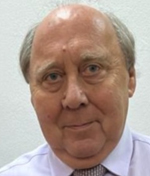Search
Session K2-1: A Century Field Effect Transistor: Past, Trends and Challenges for the Next Decade
Title:A Century Field Effect Transistor: Past, Trends and Challenges for the Next Decade
Location: Grand Ballroom, 4th Floor, Crowne Plaza Kunming City Centre
Time: 10:45-11:30, Oct. 22, 2025, Wednesday
Speaker: Prof. Cor Claeys, Fellow IEEE/EDS, Leuven, Belgium
Abstract: The micro and nanoelectronics device evolution towards fully integration in our daily life has been driven by Moore’s law, requiring the use of novel materials, the development of novel processing schemes and the switch toward novel design concepts and device architectures. Semiconductors are everywhere, are essential to solve humanitarian challenges and are at the basis of innovative technologies such as AI.
A century ago, the first patent on the Field Effect Transistor was filed by Julius E. Lilienfeld. In 1960 D. Kahng and M. Atilla demonstrated for the first time the MOSFET operation, a key building bloc of the Intel 4004 microprocessor in 1971. Nowadays, device architectures such as FinFETs, TFETs, Gate-All-Around, nanowires (NWs), nanosheets (NSs), CFET and Forksheet structures for logic and analog/RF building blocks enable System-on-Chip (SoC) applications. The strong progress achieved in silicon technology and heterogenous integration of Ge and III-V technologies on a silicon platform results in the on-chip integration of building blocks with different functionality. In addition, there is a commercial breakthrough of GaN devices, although dependent on the application competing with SiC. Major trends in process integration approaches are reviewed and technological challenges of some process modules and device structures highlighted.
Bio:
 Prof. Cor Claeys was with imec, Leuven, Belgium from 1984 till 2016 and had various managerial positions. He also became Professor at the KU Leuven (Belgium) in 1990. His main interests are semiconductor technology, device physics, low frequency noise phenomena, radiation effects and defect engineering. He is teaching a variety of short courses in different parts of the world (Europe, China, India and Brazil).
Prof. Cor Claeys was with imec, Leuven, Belgium from 1984 till 2016 and had various managerial positions. He also became Professor at the KU Leuven (Belgium) in 1990. His main interests are semiconductor technology, device physics, low frequency noise phenomena, radiation effects and defect engineering. He is teaching a variety of short courses in different parts of the world (Europe, China, India and Brazil).
He co-edited books on “Low Temperature Electronics” and “Germanium-Based Technologies: From Materials to Devices” and wrote monographs on “Radiation Effects in Advanced Semiconductor Materials and Devices”, “Fundamental and Technological Aspects of Extended Defects in Germanium”, “Random Telegraph Signals in Semiconductor Devices” and “Metals in Silicon- and Germanium-Based Technologies: Origin, Characterization, Control and Electrical Impact”. Two books are translated in Chinese. He (co)authored 16 book chapters, over 1200 conference presentations and more than 1400 technical papers (of which more than 430 in peer-reviewed scientific journal). He is editor/co-editor of 70 Conference Proceedings.
Cor Claeys is a Fellow of the Electrochemical Society and of IEEE. He was Founder of the IEEE Electron Devices Benelux Chapter, Chair of the IEEE Benelux Section, elected Board of Governors Member and EDS Vice President for Chapters and Regions. He was EDS President in 2008-2009 and Division Director on the IEEE Board of Directors in 2012-2013. He is a recipient of the IEEE Third Millennium Medal and received the IEEE EDS Distinguished Service Award. He is a Distinguished Lecture of the IEEE Electron Devices Society. Within the Electrochemical Society, he was Chair of the Electronics & Photonics Division (2001-2003). In 2004, he received the ECS Electronics & Photonics Division Award. In 2016 he received the Semi China Special Recognition Award for outstanding involvement in the China Semiconductor Technology International Conference (CSTIC).






 loading......
loading......